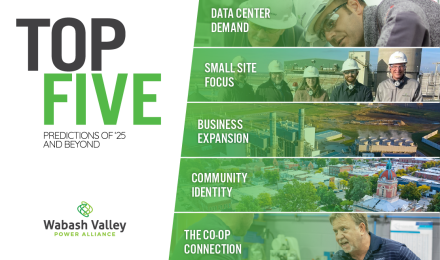While fortune tellers forecast the future through a crystal ball, economic developers scour the future frontier with a telescope – and even then, distant developments can be difficult to decipher.
 Economic development has changed significantly over the past decade. Fortunately, we at Wabash Valley Power Alliance and our member distribution cooperatives remain flexible to nimbly respond in ways that best serve our vibrant communities. We already are planning for potential developments we see unfolding in 2025 (and beyond). Our five future economic development predictions – and how we are preparing – are below.
Economic development has changed significantly over the past decade. Fortunately, we at Wabash Valley Power Alliance and our member distribution cooperatives remain flexible to nimbly respond in ways that best serve our vibrant communities. We already are planning for potential developments we see unfolding in 2025 (and beyond). Our five future economic development predictions – and how we are preparing – are below.
- Data center demand will continue; the strategies to serve them will change.
We will need to forge creative solutions and work with data centers as they become more integrated with the utility industry. The data center industry already has solved many problems previously considered insurmountable. Because of this strive for innovation, we will continue to see the sector procure its own technologies and equipment, forming partnerships with generation suppliers, and transform the utility industry in the process.
- Small site inventory will be just as important as large site potential.
Large acreage sites have been popular since 2021, while last year we saw a huge uptick in the electricity load requested for each project. While emphasis will continue to be placed on these large-acreage, large-load sites, we predict that communities focusing on more traditional locations (50 acres or less, with up to 25 MW available) will see success. Food manufacturing, plastic molding, medical device production, and agribusiness are not going out of style. Consumers will always need these items; it will be imperative that we continue to create, develop, and market these small- to middle-size sites. They will help diversify local economies and communities.
- Business expansion will need as much effort as business attraction.
Economic developers have a saying: “New business wins elections, existing business pays the bills.” Economic developers frequently focus their efforts on bringing new businesses to a community. Yet the simple truth is existing businesses deserve as many, if not more, resources.
This is why business expansion and retention efforts align so well with key accounts in the electric cooperative industry. Existing industrial members are critical to community success. While they may not generate the headlines of ribbon cuttings, the void created by existing businesses closing their doors would be devastating.
- Communities need to create an identity — or one will be imposed on them.
Communities must actively shape their own identity or risk having one imposed upon them by outside forces. Locales that take ownership of their identity foster a sense of belonging and pride among residents, making the area more appealing to new businesses, residents, and visitors.
Over the next decade, many communities will face a critical crossroads: growth or stagnation. Without intentional planning, a community’s identity can be driven by outside interests rather than local values. This is why economic developers and community leaders will play a critical role in strategic development. Through intentional focus, we can ensure a future where the community’s past is honored — and its future exciting and enriching.
- Electric cooperatives and economic developers must continue forging partnerships to thrive.
If you type “What is an electric cooperative?” into ChatGPT, one sentence sticks out: “Co-ops prioritize member interests over profits.” This spirt of cooperation and collaboration is as vital to economic development now as ever. Electric co-ops provide creative solutions to serve our members, focusing on reliability, affordability, and access to electric power. As we embark on a future where resources availability may be challenged, demand is unprecedently higher, and new generations enter the workforce, we must collaborate to creatively solve problems.
Communities preparing for economic growth need strategic planning, collaborative partnerships, and strategic investment to recruit and retain businesses. Community needs and business demands will evolve in unexpected ways. By embracing the cooperative spirit that is our foundational bedrock, we will be well-positioned to grow vibrant communities long into the future.

